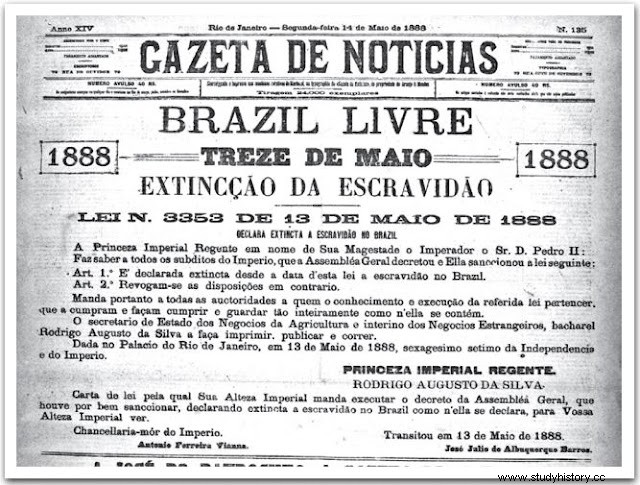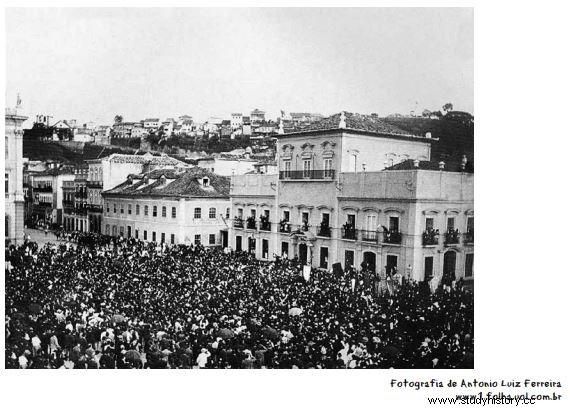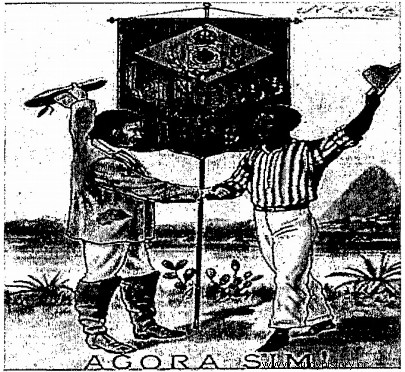
Check the alternative that correctly identifies the law to which the newspaper refers and its relationship with the process of extinction of slavery in Brazil.(A) Eusébio de Queiroz Law:tightened the inspection of laws that prohibited slavery since the first centuries of the Portuguese presence in America.(B) Eusébio de Queiroz Law:enacted after abolition, it aimed to guarantee rights and conditions for the reintegration of the freed population into Brazilian society and economy.(C) Lei Áurea:it was enacted after the proclamation of the Republic, when all imperial legislation was revoked and the issue of slavery underwent new regulation.(D) Law Áurea:established a series of legal provisions and was adopted years before abolition to ensure that, once freed, the black population was prepared for the job market.(E) Lei Áurea:represented the last step towards the abolition of slavery, that already it was gradually taking place with the adoption of laws such as the Eusébio de Queiroz, the Free Womb Law and the Sexagenarian Law.
Question 02 - UERJ 2014.2 - The signing of the Lei Áurea, on May 13, 1888, gathered a crowd in front of the Paço Imperial, in Rio de Janeiro.
 This idea that people ran out and cheered, that's legend. After the 13th of May, my great-grandfather and most of the slaves continued to live where they worked. Historical records show that some were given a piece of land to plant. But few started to earn a salary, and there were those who received a percentage of the coffee they planted and harvested − says historian Robson Luís Machado Martins, who has researched the history of his family, and that of Brazil, since the 1990s. Adapted from O Globo, 1 05/12/201 13. The photography and the report record particular aspects about the meanings of abolition, which can be associated with the following factors of the context of the time:(A) monarchical crisis − social exclusion (B) political stagnation − economic rupture(C) republican expansion − land reform(D) democratic transition − professional discrimination
This idea that people ran out and cheered, that's legend. After the 13th of May, my great-grandfather and most of the slaves continued to live where they worked. Historical records show that some were given a piece of land to plant. But few started to earn a salary, and there were those who received a percentage of the coffee they planted and harvested − says historian Robson Luís Machado Martins, who has researched the history of his family, and that of Brazil, since the 1990s. Adapted from O Globo, 1 05/12/201 13. The photography and the report record particular aspects about the meanings of abolition, which can be associated with the following factors of the context of the time:(A) monarchical crisis − social exclusion (B) political stagnation − economic rupture(C) republican expansion − land reform(D) democratic transition − professional discriminationQuestion 03 - UERJ 2001 - 1st Qualification Exam - In 1988, when the centenary of the Lei Áurea was celebrated, it was said in many cities in Brazil, ironically, that there would be a clause in the text of this law that would revoke the freedom of blacks after one hundred years of validity. The emergence of such comments is related to the following social characteristic:(A) emergence of apartheid (B) permanence of racism (C) formation of class society (D) decay of the estates system
Question 04 - UNIFOR - 2006.2 - Slave relations of production began to decline, but the main interested party in this process - the enslaved class - had no active participation. (...) The ruling class, which had created slavery, now made laws to gradually extinguish it, according to their interests. (Francisco Alencar et al. História da Sociedade Brasileira. Rio de Janeiro:ao Livro Técnico, 1994. p. 143)
The abolition of slave labor in Brazil proceeded in stages until it was completed in 1888, with the Lei Áurea. Its results in social and political terms were the immediate insertion of the recently freed people into the labor market with the support of all sectors of Brazilian society and the loss of prestige of the landlords.
(B) difficulty for the coffee plantation that lost its work force and the end of the resistance of the São Paulo farmers to immigration. (C) effective conquest of freedom by the population of African origin that had access to land tenure and the isolation of the Emperor who lost his political bases.(D) social integration of the slave with the reaffirmation of white superiority and the conquest of the right to vote guaranteed in the Constitution.(E) profound social inequality of the black population due to scarce job opportunities and the emergence of farmers in western São Paulo on the political scene.
Question 05 - ENEM 2014 - 3rd Application -
 ZIRALDO. 20 years of readiness, 1984. In:LEMOS, R. (Org.) A History of Brazil through caricature 1840-2001. Rio de Janeiro:Letras e Expressões, 2001.
ZIRALDO. 20 years of readiness, 1984. In:LEMOS, R. (Org.) A History of Brazil through caricature 1840-2001. Rio de Janeiro:Letras e Expressões, 2001. The image is related to the social situation of blacks in Brazil after the abolition of slavery, on May 13, 1888, and is a reflection of A) a law that ratified the liberation of slaves, preventing the spread of prejudice and discrimination against freedmen. B) an act by Princess Isabel, which resulted in the end of more than three centuries of slavery and made possible a dignified life for blacks.C) a law that freed the slaves, but without enabling their insertion into society and their access to basic social rights. D) a movement that developed in Brazil and that guaranteed conditions of equal access to blacks in the labor market. E) a process that, despite being slow and gradual, guaranteed citizenship to former slaves, insofar as it put end to the hideous institution of slavery.
Question 06 - UERR - 2018.1 - In the newspaper A Gazeta de Notícias of July 7, 1888, the following news appeared about the province of Minas Gerais:“... in the village of Sapucaia, those freed by the law of May 13, knowing that their former masters are organizing a republican club, have solemnly declared that they will not accept work on their farms at any price. ” Quoted by John Schulz. Army in politics, the origins of military intervention in Brazil:1850-1894. São Paulo:Edusp, 1994, p.128
Analyze the document above and answer who are the “freed by the May 13th law”? A) Italians who came to work on coffee plantations in the Vale do Paraíba region.B ) Japanese immigrants who came to Brazil.C) They are ex-slaves, freed by the Golden Law of 1888. D) The Indians who were made slaves since the arrival of the Portuguese until their freedom in 1888.E) The foreigners who arrived in the colonial period and in the face of the prohibition of Portuguese legislation in the colonial period became slaves.
Question 07 - Mackenzie 2016 - Regarding the Golden Law, read the text. “Actually, there was no longer any way to postpone the process. Simply written, the text of the law was short and direct:‘Slavery in Brazil has been declared extinct since the date of this law. Provisions to the contrary are hereby revoked'. The Treze de Maio redeemed 700,000 slaves, who represented, at that time, a small number in the total population, estimated at 15 million people. As can be seen, the liberation took too long, and represented the end of the last support of the monarchy:the carioca farmers in the Vale do Paraíba region, who were divorcing their former ally”. Lilia M. Schwarcz. The Emperor's Beard:D. Pedro II, a monarch in the tropics. 2nd ed. São Paulo:Companhia das Letras, 1998, pp. 437-438
Choose the alternative that contains the central issue for the “divorce” mentioned in the text. a) Within the ruling strata, gradual abolitionism was the main defense. However, the signing of the Lei Áurea, in 1888, was understood as a radical and desperate act of the Empire, resulting in a split between the farmers and the government. b) The definitive abolition generated material losses and led to the loss of prestige of a very active minority, extremely linked to the throne. The lack of compensation, therefore, sealed the break with the State and the adherence of that minority to republicanism. c) With the growth of the abolitionist campaign, the Empire could not deny more popular actions. The Lei Áurea represented the last act of a stable government without internal opposition, thus guaranteeing the beginning of a future Third Reign. d) Abolition represented the victory of more progressive sectors of society, represented by the farmer of Vale do Paraíba. Therefore, such an act put a brake, at least momentarily, on republican aspirations and gave the Empire a survival. e) Result of pressure from various social factors, abolitionism had its high point with the signing of the Lei Áurea. However, due to oligarchic interests, any measure in favor of consolidating the rights of the recently freed was curtailed.
Question 08 - Navy - 2018 - COLÉGIO NAVAL - Look at the image referring to the question.

(Arquivo Nacional, Rio de Janeiro) On May 13, 1888, Law No. 3353, known as Lei Áurea, which abolished slavery in Brazil. It is correct to say that among the factors that contributed to the end of slavery was; (A) the abolitionist campaign that mobilized liberal professionals, journalists, lawyers, intellectuals, among others, who acted through clubs, associations and newspapers defending the abolitionist cause. (B) the decision of Brazilian society to free the slaves, exchanging the manumission of the captives in exchange for their permanence on the land for a few more years, making the Lei Áurea a mere formality. (C) the constant attacks by quilombolas slaves led by Chico Rei on Brazilian farmers and politicians, pressuring the government to sign the abolition of slavery in exchange for an end to the murders. (D) the Proclamation of the Republic made the slavery cause unsustainable due to the participation of slaves in the Paraguayan War, leading the military to sign the law that prohibited slavery. (E) the process that led to the signing of the Golden Law was thanks to the work of Emperor D. Pedro II, who used his prestige and influence to convince Brazilian society of the importance of putting an end to the cruel form of work.
Question 09 - ENEM 2017 - PPL - The abolitionist movement, which led to the liberation of slaves by the Lei Áurea on May 13, 1888, was the first campaign of national dimensions with popular participation. Never before had so many Brazilians mobilized so intensely for a common cause, not even during the Paraguayan War. Involving all regions and social classes, it carried crowds to rallies and public demonstrations and dramatically changed the political and social relations that had prevailed in the country until then. GOMES, L. 1889. São Paulo:Globo, 2013 (adapted).
The social movement cited had as its main propagation vehicle the
The written press .
B) military officer.
C) court court.
D) Catholic clergy.
E) chamber of representatives.
Question 10 - ENEM 2007 - Considering the timeline above and the process of abolition of slavery in Brazil, tick the correct option.
 A) The abolitionist process was fast because it received the support of all political currents in the country.
A) The abolitionist process was fast because it received the support of all political currents in the country.B) The first step towards the abolition of slavery was the prohibition of the use of services by children born in captivity.
C) Before the purchase of slaves abroad was prohibited, it was decided to release the older captives.
D) Signed by Princess Isabel, the Lei Áurea concluded the abolitionist process, making slavery illegal in Brazil.
E) By abolishing the slave trade, the Eusébio de Queirós Law blocked the formulation of new anti-slavery laws in Brazil.
Question 11 - UFOP 2010/2 - The 1880s were marked by the historical process of the collapse of the monarchical political system in Brazil. The institutional structure of the Empire seemed fragile in the face of new political and social demands. Mark the alternative that indicates the decisive event of the loss of political support of the Monarchy with the rural landowners, especially in the Southeast and mainly in Rio de Janeiro:A) War against Paraguay. B) Abdication of D. Pedro I. C) Institution of the Land Law. D) Signature of the Lei Áurea.
INFORMATION 01 - E02 - A03 - B04 - E05 - C06 - C07 - B08 - A
09 - A
10 - D11 - D
